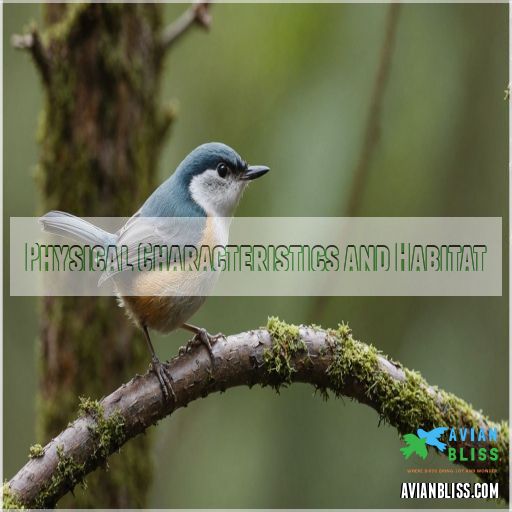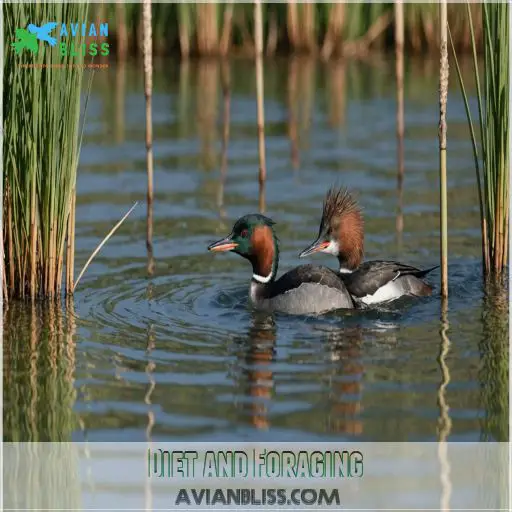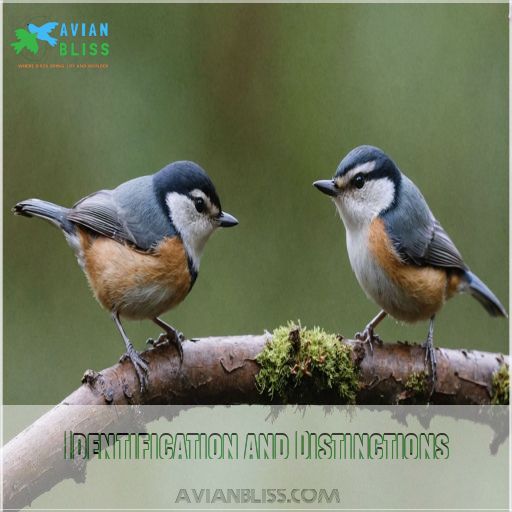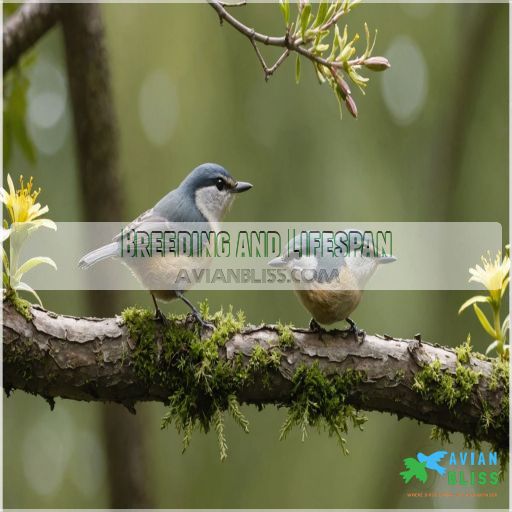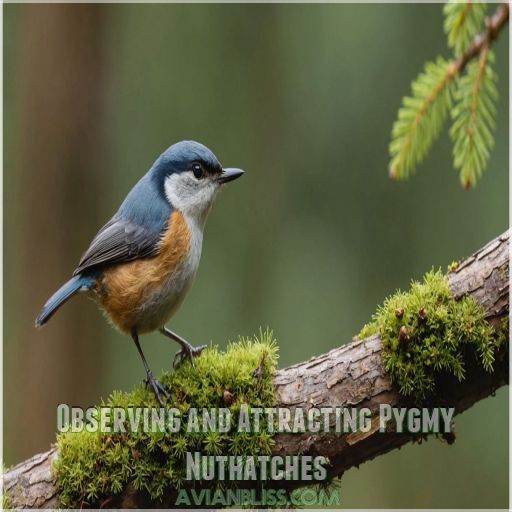This site is supported by our readers. We may earn a commission, at no cost to you, if you purchase through links.

These social birds flock together, chattering away with their peep-peep calls as they hunt insects and seeds on the highest branches. They’re nature’s little clowns, often seen hanging upside down or spiraling headfirst down tree trunks.
In winter, they huddle together in tree cavities, creating feathery cuddle puddles to stay warm. While their populations are stable, they face challenges from habitat loss and climate change.
Protecting old trees is vital for these pint-sized forest dwellers. There’s more to these quirky birds than meets the eye – their survival strategies might surprise you.
Table Of Contents
- Key Takeaways
- Physical Characteristics and Habitat
- Social Behavior and Nesting
- Diet and Foraging
- Vocalizations and Unique Features
- Conservation Status and Threats
- Identification and Distinctions
- Breeding and Lifespan
- Observing and Attracting Pygmy Nuthatches
- Frequently Asked Questions (FAQs)
- Where do pygmy nuthatch live?
- What does a pygmy nuthatch look like?
- Are pygmy nuthatches social?
- Are pygmy nuthatches tame?
- How do you identify a pygmy nuthatch?
- What is the difference between pygmy and white breasted nuthatches?
- What is the lifespan of a pygmy nuthatch?
- What bird looks like a nuthatch but smaller?
- How do pygmy nuthatches adapt to urban environments?
- Whats the pygmy nuthatchs role in forest ecosystems?
- Do pygmy nuthatches migrate or stay year-round?
- How do pygmy nuthatches interact with other bird species?
- What are the pygmy nuthatchs main predators?
- Conclusion
Key Takeaways
- You’ll find these pint-sized acrobats zipping through ponderosa pine forests, hanging upside down, and spiraling headfirst down tree trunks like nature’s little clowns. They’re not just cute; they’re crucial for insect control and seed dispersal in their ecosystems.
- These social birds take "it takes a village" to heart, with cooperative breeding that’s like having built-in babysitters. They’ll cuddle up in tree cavities during winter, creating feathery cuddle puddles of up to 150 birds to stay warm.
- While they’re not picky eaters, switching between insects in summer and seeds in winter, they’re master food hoarders. They’ll tuck seeds into tree crevices like squirrels with wings, ensuring they’ve got snacks on hand when the going gets tough.
- You can attract these chirpy neighbors to your backyard by offering suet, sunflower seeds, and peanuts. Just remember, if you build it (a nest box), they might come – but only if you’ve got some tall pines around for them to call home.
Physical Characteristics and Habitat
Picture a pygmy nuthatch with its gray-brown cap and sparrow-like size, blending effortlessly into its favorite pine forest.
You’ll find these birds hanging out in high-altitude areas across western North America, making their home in old trees and snags, as if they’re saying, "There’s no place like a Black Swift habitat in the woods
.
Gray-brown Cap and Pale Underside
Imagine a charming pygmy nuthatch sporting its iconic gray-brown cap and pale underside as it flits through the ponderosa pines of North America. Its coloration offers perfect camouflage against tree trunks, making identification a delightful challenge.
Usually, you’ll find them clinging to branches in:
- Pine forests
- Aspen groves
- High in the canopy
This little bird’s plumage varies subtly, enhancing its allure.
Size Comparison to Sparrows
When you stack a pygmy nuthatch beside a sparrow, size stands out.
These little nuthatches, charming as they’re with a nuthatch size range comparable to a child’s fist, are smaller than most sparrows.
While sparrow size variation is notable, this size difference impacts how they dart around bird feeder visitors, and outmaneuver even a curious red squirrel, impacting their behavior around bird feeders and other backyard wildlife
.
Preferred Pine Forests and Tree Species
Fancy a stroll through an open, parklike pine forest?
You’d find it’s where Pygmy Nuthatches feel right at home. These birds have a soft spot for ponderosa pines but they’re also partial to other diverse pine species.
Avoid areas impacted by logging; dense forests managed carefully with controlled fire effects support their happy habitats, encouraging them to thrive.
Elevation Range in Western North America
Pygmy nuthatches thrive in the mountainous regions of western North America, with their preferred elevation ranging from 300 to 750 meters.
These tiny, energetic birds are found in ponderosa pine forests, often sharing the canopy with Douglas-fir and western larch.
As the climate warms, their habitat may expand to higher elevations, but they’ll always be at home among the tall pines in their preferred elevation.
Importance of Old Trees and Snags
Life up in the Western elevations requires resources. You see, old trees and snags are like luxury condos for pygmy nuthatches, providing essential roosting and nesting sites.
Imagine the impact of their absence:
- Snag Ecology: Reduces biodiversity.
- Cavity Nesters: Lack safe nesting space.
- Deadwood Importance: Affects insect population control.
- Habitat Loss: Looms as a threat.
Social Behavior and Nesting
When you’re observing the pygmy nuthatch, you’ll quickly notice their friendly nature.
Often hanging out in flocks and working together to raise their young, these little birds demonstrate a unique social behavior.
Like a community band, they build cozy nests in snug dead limbs.
Showing a teamwork spirit that puts some human families to shame.
Highly Sociable Birds in Flocks
Spotting these cheerful flocks is like watching nature’s social club in action. Their flocking behavior is a vibrant display of social dynamics and communication, essential for breeding success and winter survival. Imagine them sharing secrets and laughs as they flit about.
| Emotion | Behavior | Season |
|---|---|---|
| Joy | Spirited Chatter | Year-round |
| Curiosity | Flock Exploration | Breeding |
| Togetherness | Communal Roosting | Winter |
These behaviors highlight their need to belong.
Cooperative Breeding With Multiple Helpers
Imagine a family reunion, but with feathers and flight.
In Pygmy Nuthatches, cooperative breeding involves multiple helpers.
While these helpers mightn’t parent their own chicks, they benefit from kin selection by boosting their siblings’ survival chances.
This evolutionary strategy reduces individual costs and prepares them for future parenting, proving that teamwork makes the dream work .
Nesting in Dead Limbs or Snags
You’ll find the Pygmy Nuthatches nesting in dead limbs or snags, expertly choosing these spots for nest site selection. Their love for snag availability speaks to their savvy nature.
They charm you with:
- Cavity Excavation: Crafty nest creation.
- Predator Defense: Snags offer protection.
- Nesting Success: High in these spots.
- Community Spirit: Helpers abound.
Definitely masters of their craft!
Nest Material and Construction
Building a home, pygmy nuthatches cleverly select nest cavities and diligently repurpose materials. You might spot them using bark and feathers for nest lining variations, while their helpers play key roles in construction.
Their nest defense strategies are impressive, like fortresses in the bird world.
| Material | Purpose |
|---|---|
| Bark | Structure support |
| Feathers | Insulation |
| Pine needles | Cushioning |
| Spider silk | Binding agent |
Roosting Together in Winter
On the coldest winter nights, flocks of Pygmy Nuthatches huddle together in cozy tree cavities, sometimes numbering over 150 birds.
This strategy helps them conserve precious body heat and avoid hypothermia.
By snuggling up, they can lower their metabolic rate and stay toasty warm, while also defending against predators.
It’s a win-win for these pint-sized pine forest dwellers!
Diet and Foraging
You’ve got a curious bird here with the Pygmy Nuthatch.
They are bustling about the highest branches for tasty insects in summer and hoarding pine seeds through winter.
They play hide and seek with their food, tucking seeds into tree crevices, and you’ll rarely catch them on the ground looking for a snack.
Insect-based Diet in Summer
During summer, Pygmy Nuthatches indulge in a buffet of beetles, wasps, caterpillars, and true bugs, thanks to the generous summer insect availability.
These nimble birds prefer foraging on the highest branches of pines, performing acrobatics that could make a gymnast proud.
It’s like their own high-flying insect hunt—talk about a literal taste for the high life!
Seed-based Diet in Winter
As summer’s insect buffet closes, the Pygmy Nuthatch’s menu flips to seeds. It’s like folding away a picnic blanket when winter rolls around.
These acrobatic little birds rely on pine seeds, performing daring maneuvers to access cones high atop trees.
Seed storage becomes their savior, ensuring winter survival, with a preference for the best pine cones available.
Food Storage in Tree Crevices
Imagine you’re a Pygmy Nuthatch. You’d expertly tuck seeds into tree crevices, crafting caches that are winter survival’s secret weapons.
This clever food storage strategy plays a key role in predator avoidance, with cache recovery becoming a fine art.
So, the next time you’re contemplating life’s necessities, remember the humble nuthatch’s approach—planning brings freedom.
Foraging on Outermost Pine Branches
Look up at those acrobats!
Pygmy Nuthatches dance on outermost pine branches, favoring cones with their nimble moves. They deftly extract insects lurking in crevices, prioritizing pine cone preference.
Winter foraging sees their focus shift to savoring and caching seeds, all while avoiding food competition.
These tiny daredevils turn treetops into bustling dining arenas, showcasing their winter foraging skills.
Rare Ground Foraging and Insect Capture
While mostly high-flyers among pine branches, Pygmy Nuthatches sometimes engage in rare ground foraging, a behavior also seen in their larger cousins, the White-breasted Nuthatches, who often cache seeds in bark crevices.
This seed caching technique by the White-breasted Nuthatches showcases their resourcefulness in adapting to changing environments.
Imagine this: a tiny bird exploring earth’s crevices for hidden insect treasures. Their occasional ground-hopping showcases remarkable adaptation in foraging techniques, influenced by habitat and seasonal variations.
Such behavior underscores their ecological significance, ensuring insects don’t overstay their welcome—like uninvited guests who never leave!
Vocalizations and Unique Features
You’ll be charmed by the pygmy nuthatch’s melodious calls and duck-like vocalizations.
Look for the distinctive white spot on the nape and the bird’s undulating flight pattern as it forages high in the pine trees, exhibiting expert camouflage strategies
.
Monotonous Peep Call Pattern
For calling, the Pygmy Nuthatch is like your chatty neighbor—consistently delivering its monotonous peep pattern. This vocalization is key for communication within flocks and varies little, yet it’s surprisingly effective in call recognition and call mimicry.
- Connects flocks foraging together
- Reminds you of a gentle doorbell
- Demonstrates call evolution
- Highlights nature’s simplicity
Undulating Flight Pattern
Imagine a tiny acrobat, executing an undulating flight pattern that’s a marvel of flight mechanics.
Energy efficiency and aerial acrobatics help the Pygmy Nuthatch zip around with navigational advantage, dodging tree branches like a seasoned pilot.
Evolutionary adaptations make this little bird’s flight a spectacle, balancing grace and agility in nature’s air show.
White Spot on Nape
Fascinated by their gravity-defying antics, you’d notice the pygmy nuthatch’s white spot on its nape as more than a quirky fashion choice.
This unique marking serves as a handy identification tool and offers a camouflage advantage in their pine forest homes.
It can also play a role in visual signaling among their merry flocks, enhancing communication.
Comparison to Brown-headed Nuthatches
Spotting that white nape, you might wonder how Pygmy Nuthatches stack up against their Brown-headed cousins.
While both squeak like rubber duckies, Brown-headed Nuthatches boast complex calls and socially intricate vocalizations, reflecting their cooperative nesting lifestyle (Source).
Pygmy Nuthatches, with their simple but melodic peeps, thrive in Western pine habitats, charming listeners with their unique, rhythmic tunes .
Ecological Role in Insect Control
Hear that monotonous "peep"? That’s the Pygmy Nuthatch quietly acting as nature’s pest control expert.
By keeping insect populations in check, these birds help maintain insect balance and keep the forest healthy.
Enjoy watching this predator-prey dance as they tackle beetles and caterpillars, doing their part to keep the ecosystem thriving while offering you a peek into nature’s clever design.
Conservation Status and Threats
The good news is that pygmy nuthatches are still common, with stable population numbers.
However, climate change and habitat loss due to logging pose real threats that could impact this charismatic little bird down the road.
Stable Population Numbers
Pygmy Nuthatches serenade you with their peeps, sharing tales of stable population numbers.
Their conservation success and remarkable climate resilience help them sing their way through life.
Habitat management plays a key role in these positive population trends. Maintaining old trees keeps their roosts safe, minimizing threats to stability and allowing these lively nuthatches to thrive.
Climate Change-driven Threats
Imagine the huge challenge Pygmy Nuthatches face with climate change.
With warming temperatures, you’ll see habitat shifts and range expansion as they search for food availability that’s dwindling.
Drought impacts and altered fire regimes can leave them homeless, akin to losing your favorite hideaway in the woods.
These changes threaten their survival, sparking a call for action to support their survival, and address the impacts of habitat shifts .
Habitat Loss and Logging Impact
Imagine this: your cozy pine forest is shrinking due to forest fragmentation and logging.
It seems like a bad dream for Pygmy Nuthatches.
Snag removal and fire suppression destroy their habitats, disrupting nesting sites.
Supporting sustainable logging and strong conservation efforts can make a real difference, ensuring these lively birds continue gracing our forests.
Importance of Dead Trees and Snags
During your forest wanderings, don’t overlook snags.
These dead trees serve as cozy lodgings for cavity-nesters like the Pygmy Nuthatch.
With snag decay speeding habitat loss, thoughtful forest management becomes really important.
Protecting these wildlife refuges helps maintain bird populations.
Let’s protect their natural hotels before they become extinct, giving nature-loving creatures a safe haven.
Nest Box Installation for Disturbed Forests
You’ve got the power to be a pygmy nuthatch‘s hero. Mature forests with closed canopies, similar to those preferred by the northern goshawk Northern Goshawk Habitats, are also essential for the pygmy nuthatch’s survival.
In disturbed forests where natural cavities are scarce, nest boxes can be a lifeline for these tiny acrobats . By installing and monitoring nest boxes, you’re not just providing homes; you’re restoring habitats and making a real conservation impact.
- A cozy pine-scented retreat high in the trees
- Curious beady eyes peeking out from a round entrance
- Soft moss and feathers lining a snug wooden chamber
- Cheerful peeps of grateful nuthatches settling into their new digs
Identification and Distinctions
You’ll spot a pygmy nuthatch by its tiny size and unique behaviors, setting it apart from its nuthatch cousins.
It’s like the acrobat of the pine forest, zipping headfirst down tree trunks and hanging upside down from branches with ease, especially notable for its ability to move headfirst down tree trunks.
Distinguishing Features From Other Nuthatches
From habitat loss concerns, let’s appreciate what sets the Pygmy Nuthatch apart.
It sports a nape spot and a sleeker bill shape than its relatives. It’s also smaller, only about 3.5 inches long—a fun-sized avian marvel!
Preferring the lofty heights of ponderosa pine forests, its call is vibrant and distinct—a melodious character you’ll always remember.
Comparison to White-breasted Nuthatches
Spotting the difference between pygmy and white-breasted nuthatches is like solving a feathered puzzle.
While both sport blue-gray backs, the pygmy’s brown cap ends with a sharp eye line, contrasting with the white-breasted’s black crown and stark white cheeks, a color combination found in many black birds with white heads
.
Their behavior sets them apart too – pygmies are social butterflies, often seen in family flocks, while white-breasted nuthatches prefer a more solitary lifestyle (Source).
Smaller Size Than Other Nuthatches
The Pygmy Nuthatch is truly a pint-sized powerhouse! As the smallest of its family, it’s like the Mighty Mouse of the forest.
- Size comparison: At just 4.25 inches, it’s barely bigger than a ping-pong ball
- Adaptations: Its compact body is perfect for zipping through pine needles
- Foraging habits: It’s a master acrobat, often hanging upside-down to snatch insects
Don’t let its size fool you – this little guy’s got a big personality!
Breeding and Lifespan
You’ll find the pygmy nuthatch’s breeding habits as quirky as their name suggests.
These tiny birds team up with helpers to raise their young.
Often producing a single brood of 6-8 eggs each year in cozy cavities high up in pine trees.
Breeding Season and Nesting Behavior
Spring fever hits pygmy nuthatches hard. You’ll find these lovebirds busily preparing their nests in tree cavities or snags, much like chickadees who utilize a variety of nesting sites, such as cavities in dead trees, and nest boxes to avoid predators chickadee nests.
They’re picky homeowners, preferring dead trees or broken treetops, often selecting habitats with mature trees, dead snags, and available cavities. Their cozy nests are lined with fur and feathers to create a perfect nursery.
Their nests are home to 2-8 eggs, with an impressive nesting success rate of 80% in some areas, making these little birds overachievers that often have multiple offspring per brood.
Cooperative Breeding With Helpers
You’ll be amazed by the Pygmy Nuthatch’s family values.
These little birds take "it takes a village" to heart. After nesting, they’ll often recruit helpers, usually their own offspring from previous years, to lend a wing.
This cooperative breeding strategy has evolved through kin selection, offering benefits like increased success rates and survival chances for the whole clan.
It’s like they’ve cracked the code of avian teamwork!
Lifespan of Pygmy Nuthatches
While these feathered friends band together for breeding, their time on Earth is fleeting. Pygmy nuthatches live life in the fast lane, with an average lifespan of just 1.7 years. But don’t let that short timeline fool you!
These little dynamos pack a punch:
- Highly successful breeders
- 80% of nests fledge multiple young
- Thrive in undisturbed old-growth forests
- Face threats from logging and fire suppression
- Serve as indicators of healthy Ponderosa Pine ecosystems
Their brief lives are a reminder: every moment counts in nature’s grand design.
Brood Size and Nesting Success
Pygmy Nuthatches are overachievers in terms of family life. These tiny powerhouses typically lay 4-9 eggs per clutch, with an average of 6-7 (Source). Talk about a full house!
Their nesting success is a team effort, thanks to their cooperative breeding strategy. It’s like they’ve got a built-in babysitting service, with helpers pitching in to feed and protect the nestlings.
This family-first approach gives their little ones a fighting chance in the wild, and it’s a remarkable testament to the birds’ ability to work together for the greater good, with a strong sense of family-first.
Factors Affecting Breeding Success
Several factors can make or break a Pygmy Nuthatch’s breeding success. Nest-site competition with other cavity-nesters can leave couples homeless. Climate change might throw a wrench in their plans, altering food availability and nesting schedules.
On the bright side, helper effects from previous offspring can boost survival rates. It’s like having built-in babysitters!
Food availability plays a major role, while brood parasitism remains a potential party crasher in their family-planning efforts.
Observing and Attracting Pygmy Nuthatches
You’ll find pygmy nuthatches zipping through pine forests, their tiny bodies barely visible as they forage high in the treetops.
To attract these sociable birds to your yard, set up nest boxes and offer a buffet of sunflower seeds and suet – they’ll reward you with their cheerful peeps and acrobatic antics.
Observing Tips for Pygmy Nuthatches
Bird-watching bliss awaits in ponderosa pine forests!
You’ll spot nuthatch flocks acrobatically foraging on high branches. Listen for their cheerful "peep-peep" calls. Bring binoculars to catch their upside-down antics and white nape spots.
For a real treat, arrive at dusk to witness their cozy communal roosting . Remember, patience is key – these social butterflies of the pine world might just steal your heart!
Attracting Pygmy Nuthatches to Backyards
Now that you’ve spotted these charming acrobats, why not invite them to your yard?
Create a pygmy paradise with coniferous trees and dead snags. Stock feeders with their favorites: suet, sunflower seeds, and peanuts.
For a real treat, offer live mealworms in a shallow tray.
Don’t forget water sources near trees or brush piles for quick retreats. With patience, you’ll soon have a feathered friends calling your backyard home, creating a quick retreats.
Installing Nest Boxes for Pygmy Nuthatches
Ready to roll out the welcome mat for pygmy nuthatches? These pint-sized acrobats love a cozy home, much like their larger cousins, the red breasted nuthatches, known for their agile climbing techniques.
Craft a wooden palace with an 11-by-8-inch frame and a 1-inch entrance hole. Mount it on a south or east-facing tree in open pine forests.
For best results, space boxes 240 feet apart and leave them up year-round – these social butterflies might use them for winter sleepovers too!
Providing Food for Pygmy Nuth
Want to turn your backyard into a pygmy nuthatch haven? You’ll be tickled pink by these tiny acrobats!
- Hang suet feeders packed with peanut butter-rich treats
- Offer a smorgasbord of sunflower seeds and unsalted peanuts
- Serve up live mealworms for a protein-packed feast
Don’t forget to keep water sources nearby – a shallow rock dip might become their favorite spa day spot!
Frequently Asked Questions (FAQs)
Where do pygmy nuthatch live?
Like tiny acrobats in a pine forest circus, they’ve found their niche.
You’ll spot these energetic birds in open, parklike stands of ponderosa and other long-needled pines across the western U.S., up to 10,000 feet in California mountains.
What does a pygmy nuthatch look like?
You’ll spot this tiny acrobat by its crisp brown cap, slate-grey back, and whitish underparts.
With a sharp, straight bill and large rounded head, it’s a pint-sized powerhouse clambering up pines, chattering away with squeaky cheeps.
Are pygmy nuthatches social?
These tiny birds are the life of the pine party.
They flock together, breeding cooperatively and huddling cavities on chilly nights.
You’ll find them chattering away, foraging with other species, and even snuggling up to 150 strong in a single tree.
Are pygmy nuthatches tame?
Tameness in birds often depends on their environment and interactions.
While not typically ‘tame,’ pygmy nuthatches can be bold and curious. Their friendly demeanor might fool you, but it’s their natural courage shining through.
They’re just being their adventurous selves!
How do you identify a pygmy nuthatch?
Look for a tiny, energetic bird with a gray-brown cap and bluish-gray back.
Listen for rubber-ducky calls as they climb ponderosa pines.
They’re often in flocks, so if you spot one, more are likely nearby.
What is the difference between pygmy and white breasted nuthatches?
Our feathered friends differ in size and style.
Pygmy nuthatches are tiny with brown caps, while white-breasted sport black caps and stark white cheeks.
You’ll spot pygmies out west, but white-breasted nuthatches roam nationwide.
Both rock at upside-down tree climbing!
What is the lifespan of a pygmy nuthatch?
These tiny feathered friends live fast and die young.
On average, pygmy nuthatches only stick around for about 7 years.
But don’t let their short lifespan fool you – they pack a lot of living into those months!
What bird looks like a nuthatch but smaller?
Did you know that some birds smaller than nuthatches can fly directly into their nests to avoid sticky pine sap?
The Red-breasted Nuthatch, a tiny acrobat, looks like its larger cousin but with a rusty belly and more compact build.
How do pygmy nuthatches adapt to urban environments?
While typically at home in pine forests, these tiny acrobats are learning to thrive in urban settings.
They’ll nest in birdhouses, feast on suet feeders, and chatter away in city parks, proving they’re not just tree huggers .
Whats the pygmy nuthatchs role in forest ecosystems?
Like nature’s tiny janitors, these feathered friends play a vital role.
They’re involved in various activities, such as munching on pesky insects, dispersing pine seeds, and creating homes that other critters use.
They’re the unsung heroes of forest health.
Do pygmy nuthatches migrate or stay year-round?
You’ll find these tiny birds sticking around all year.
They’re homebodies, rarely leaving their pine forest homes.
Only in years when pine cones are scarce might they wander to lower elevations, but it’s not a true migration.
How do pygmy nuthatches interact with other bird species?
Social butterflies and fierce defenders, these tiny birds join mixed flocks but won’t hesitate to chase away woodpeckers threatening their food caches.
They’re the life of the forest party, foraging with chickadees and crossbills while fiercely guarding their pine seed stashes.
What are the pygmy nuthatchs main predators?
Hawks, owls, and other raptors pose the biggest threat to these tiny acrobats.
Tree-dwelling snakes and squirrels also lurk as potential predators.
You’ll often spot pygmy nuthatches in chatty flocks, their safety-in-numbers strategy keeping watchful eyes peeled.
Conclusion
Like Tolkien’s hobbits of the forest, pygmy nuthatches remind us that small creatures can have big impacts.
These tiny acrobats of the pines play a key role in their ecosystems, from pest control to seed dispersal.
As you explore western forests, keep an ear out for their peeping calls and an eye on treetops for their upside-down antics.
By protecting old-growth forests and installing nest boxes, you’re not just helping pygmy nuthatches – you’re preserving a vital piece of nature’s intricate puzzle.

